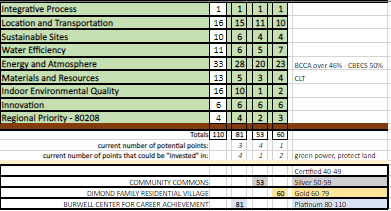This article is part one of a four-part series detailing DU’s efforts to achieve a sustainable campus, considering past and present accomplishments. Now is the critical time to address global warming and the environmental issues that threaten to spiral into worse disasters like the COVID-19 pandemic.
DU has six Leadership in Energy and Environmental Design (LEED) certifications on campus, soon to be nine with the likely additions of new buildings. While this sounds impressive, more information about these certifications is necessary in order to truly evaluate DU’s commitment to sustainability.
The environmental movement gained momentum in the 1970s, sparking interest in sustainable practice technologies like renewable energy sources and green buildings. The non-profit U.S. Green Building Council developed a third-party system to verify the authenticity of green building designs and operations.
The international Leadership in Energy and Environmental Design (LEED) organization grants tiered certifications based on the degree of a building’s sustainability. From lowest to highest, the tiered system grants “Certified,” “Silver,” “Gold” or “Platinum” certifications.
Although accepted internationally, LEED certification is not a perfect system for evaluating sustainability. There are fees to register and certify buildings, which is a financial de-incentivization. It takes time and effort for a building’s architect and management to demonstrate the sustainable aspects of the design.
A LEED certification may not be necessarily impressive because the requirements for the lower tiers are only marginally more stringent than standard building code. Building teams can design, operate and pay for the Certified or Silver status relatively easily. However, the higher Gold and Platinum levels are more remarkable as they require investment and conscientious design.
Despite the controversy surrounding LEED certifications, DU demonstrates a genuine desire for sustainability by acquiring these higher-tiered LEED certifications. The university started prioritizing sustainable efforts decades ago by emphasizing interdisciplinary cooperation and research.
The certification process requires a LEED-certified consultant and compliance with a list of sustainable criteria. DU takes pride in earning Gold and Platinum certifications; although these recognitions are more expensive and require conscientious design and construction, the upfront investment is worth the long-term energy and resource savings.
The LEED certification process evaluates categories like location and transportation, water efficiency, energy, atmosphere and indoor air quality. Utilizing native plant species and xeriscaping (landscaping that requires little or no irrigation) are popular mechanisms of water conservation that contribute to a LEED certification.

Nine buildings at DU will be officially LEED-certified, but 14 have been designed and reviewed by the university’s architect, sustainability representatives and consulting team to meet the criteria. These efforts show DU’s prioritization of environmental design and practice, independent from the imperfect LEED system.
DU’s Ricketson Law Building became the nation’s first LEED Gold certified law school building in 2003. It features a rain collection cistern (precipitation is captured in a storage unit used for landscaping or plumbing), low-impact water fixtures and efficient windows that retain heat while allowing in natural light.
Ruffatto Hall, Nagel Hall and the Administrative Office buildings are also all LEED Gold certified. They feature water-efficient landscaping, reduced energy consumption and copper roofs made from 95% recycled material. These buildings also boast “thermo-retaining masonry,” which reduces emissions from heating and cooling systems.
Anderson Academic Commons and Margery Reed Hall were LEED Silver certified but upgraded to Gold after renovations. They feature efficient windows that maintain building temperatures and low-flow water fixtures, reducing emissions and water usage.
The new Burwell Center, Dimond Residential Village and Community Commons buildings are in the process of acquiring LEED certifications in “new design and construction” which requires conscientious upfront planning, said DU’s sustainability director, Chad King. With the Burwell Center especially, DU hopes to earn an additional certification for “operations and management” as well.
The Community Commons is expected to earn a Silver certification, and the Dimond Residential Village will likely receive a Gold certification. The Burwell Center for Career Achievement is expected to earn DU’s first Platinum certification.
The LEED system is not a perfect evaluation of sustainability, but DU has used the system as a basic guide, striving to go above and beyond the criteria for environmental health.











